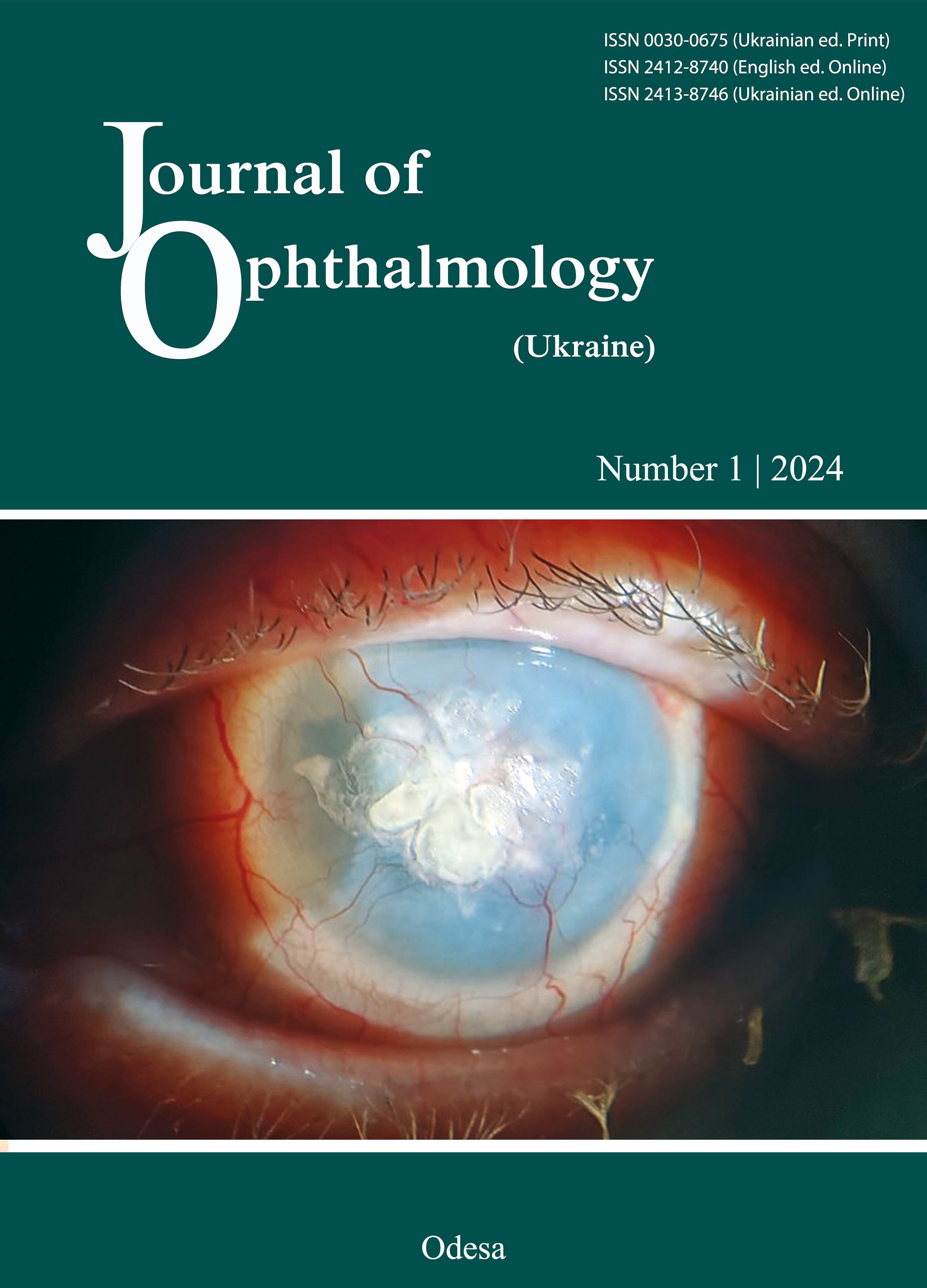Detecting diabetic retinopathy using an artificial intelligence-based software platform: a pilot study
DOI:
https://doi.org/10.31288/oftalmolzh202412731Keywords:
diabetes mellitus, diabetic retinopathy, artificial intelligenceAbstract
Purpose: To examine the potential for the detection of diabetic retinopathy (DR) using the artificial intelligence (AI)-based software platform Retina-AI CheckEye©.
Material and Methods: This was an open-label, prospective, pilot observational case-control study for the detection of DR using an AI-based software platform. The study was conducted at the sites of healthcare facilities in Chernivtsi oblast. Four hundred and eight diabetics and 256 non-diabetic controls were involved in the study. All fundus images were analyzed using the artificial intelligence (AI)-based software platform Retina-AI CheckEye©. Receiver operating characteristic (ROC) curve analysis was performed to determine the sensitivity and specificity of the DR diagnosis method.
Results: Using the AI-based software platform, signs of DR in at least one eye were detected in 143 diabetics (22% of total study subjects (664 individuals; 1328 eyes) or 35% of the diabetics (408 patients)). No DR signs were detected in 322 individuals (48% of total study subjects). In 199 individuals (30% of total study subjects), the results were not obtained due to the features of the optical media and presence of certain eye diseases (in most cases, unilateral cataract or corneal opacity). This trial found 93% sensitivity and 86% specificity for the Retina-AI CheckEye-assisted detection of DR.
Conclusion: An AI-based software platform, Retina-AI CheckEye©, has been for the first time developed in Ukraine. The platform was demonstrated to have a high accuracy (93% sensitivity and 86% specificity) in diagnosing DR in diabetic patients and can be used for large-scale DR screening.
References
Sun H, Saeedi P, Karuranga S, et al. IDF Diabetes Atlas: Global, regional and country-level diabetes prevalence estimates for 2021 and projections for 2045. Diabetes Res Clin Pract. 2022 Jan:183:109119. https://doi.org/10.1016/j.diabres.2021.109119
Alessi J, Yankiv M. War in Ukraine and barriers to diabetes care. Lancet. 2022 Apr 16;399(10334):1465-1466. https://doi.org/10.1016/S0140-6736(22)00480-9
Gale R, Scanlon PH, Evans M et al. Action on diabetic macular oedema: achieving optimal patient management in treating visual impairment due to diabetic eye disease. Eye. 2017;31(1):1-20. https://doi.org/10.1038/eye.2017.53
Jones LD, Golan D, Hanna SA, Ramachandran M. Artificial intelligence, machine learning and the evolution of healthcare: A bright future or cause for concern? Bone Joint Res. 2018;7(3):223-225. https://doi.org/10.1302/2046-3758.73.BJR-2017-0147.R1
Abràmoff MD, Folk JC, Han DP, Walker JD, Williams DF, Russell SR, et al. Automated analysis of retinal images for detection of referable diabetic retinopathy. JAMA Ophthalmol. 2013;131(3):351-7. https://doi.org/10.1001/jamaophthalmol.2013.1743
Hsieh YT, Chuang LM, Jiang YD, Chang TJ, Chan LW, Kao TY, et al. Application of deep learning image assessment software VeriSeeTM for diabetic retinopathy screening. J Formos Med Assoc. 2021;120(1):165-71. https://doi.org/10.1016/j.jfma.2020.03.024
Hansen MB, Abràmoff MD, Folk JC, Mathenge W, Bastawrous A, Peto T. Results of automated retinal image analysis for detection of diabetic retinopathy from the Nakuru study, Kenya. PLoS One. 2015;10(10):e0139148. https://doi.org/10.1371/journal.pone.0139148
Bejnordi BE, Zuidhof G, Balkenhol M et al. Context- aware stacked convolutional neural networks for classification of breast carcinomas in whole-slide histopathology images. J Med Imaging (Bellingham). 2017;4(4):е44504. https://doi.org/10.1117/1.JMI.4.4.044504
Esteva A, Kuprel B, Novoa RA, Ko J, Swetter SM, Blau H M, et al. Dermatologist-level classification of skin cancer with deep neural networks. Nature. 2017;542(7639):115-118. https://doi.org/10.1038/nature21056
Weng SF, Reps J, Kai J, Garibaldi JM, Qureshi N. Can machine-learning improve cardiovascular risk prediction using routine clinical data. PLoS One. 2017;12(4):e174944. https://doi.org/10.1371/journal.pone.0174944
Van Ginneken B. Fifty years of computer analysis in chest imaging: rule-based, machine learning, deep learning. Radiol Phys Technol. 2017;10:23-32. https://doi.org/10.1007/s12194-017-0394-5
Shimizu E, Tanji M, Nakayama S, et al. AI-based diagnosis of nuclear cataract from slit-lamp videos. Sci Rep. 2023 Dec 12;13(1):22046.
https://doi.org/10.1038/s41598-023-49563-7
Kapoor R, Whigham BT, Al-Aswad LA. The Role of Artificial Intelligence in the Diagnosis and Management of Glaucoma. Curr Ophthalmol Rep. 2019;7(2):136-142. https://doi.org/10.1007/s40135-019-00209-w
Cheung R, Chun J, Sheidow T et al. Diagnostic accuracy of current machine learning classifiers for age-related macular degeneration: a systematic review and meta-analysis. Eye (Lond). 2022 May;36(5):994-1004. Epub 2021 May 6. https://doi.org/10.1038/s41433-021-01540-y
Lee SY, Ting DSW, Cheung CYL et al. Development and Validation of a Deep Learning System for Diabetic Retinopathy and Related Eye Diseases Using Retinal Images from Multiethnic Populations with Diabetes. JAMA. 2017;318(22):2211-2223. https://doi.org/10.1001/jama.2017.18152
Lee AY, Yanagihara RT, Leе CS, Jung HC, Chee YE, Gencarella MD, et al. Multicenter, Head-to-Head, Real-World Validation Study of Seven Automated Artificial Intelligence Diabetic Retinopathy Screening Systems. Diabetes Care. 2021;44(5):1168-75. https://doi.org/10.2337/dc20-1877
Caixinha M, Nunes S. Machine learning techniques in clinical vision sciences. Current Eye Research. 2017;42(1):1-15. https://doi.org/10.1080/02713683.2016.1175019
Abràmoff MD, Lavin PT, Birch M, Shah N, Folk JC. Pivotal trial of an autonomous AI-based diagnostic system for detection of diabetic retinopathy in primary care offices. NPJ Digit Med. 2018;1:39. https://doi.org/10.1038/s41746-018-0040-6
Lee AY, Yanagihara RT, Lee CS, Blazes M, Jung HC, Gencarella MD et al. Multicenter, Head-to-Head, Real-World Validation Study of Seven Automated Artificial Intelligence Diabetic Retinopathy Screening Systems. Diabetes Care. 2021;44(5):1168-1175 https://doi.org/10.2337/dc20-1877
Rahimy E. Deep learning applications in ophthalmology. Curr Opin Ophthalmol. 2018;29(3):254-60. https://doi.org/10.1097/ICU.0000000000000470
Weiss S, Kulikowski CA, Safir A. Glaucoma consultation by computer. Comput Biol Med. 1978;8(1):2540. https://doi.org/10.1016/0010-4825(78)90011-2. https://doi.org/10.1016/0010-4825(78)90011-2
Abràmoff MD, Lou Y, Erginay A, Clarida W, Amelon R, Folk JC, et al. Improved automated detection of diabetic retinopathy on a publicly available dataset through integration of deep learning. Invest Ophthalmol Vis Sci. 2016;57:5200-6. https://doi.org/10.1167/iovs.16-19964
Copeland J. Artificial intelligence: A philosophical introduction. John Wiley & Sons: Oxford: Blackwell Publishers Ltd. 1993.
Hashimoto DA, Rosman G, Rus D, Meireles O R. Artificial Intelligence in Surgery: Promises and Perils. Ann. Surg. 2018;268(1):70. https://doi.org/10.1097/SLA.0000000000002693
Wewetzer L, Held LA, Steinhäuser J. Diagnostic performance of deep-learning-based screening methods for diabetic retinopathy in primary care - a meta-analysis. PLoS One. 202116(8):e0255034. https://doi.org/10.1371/journal.pone.0255034
Grzybowski A, Brona P. Approval and Certification of Ophthalmic AI Devices in the European Union. Ophthalmology and Therapy.2023;12(2):1-6. https://doi.org/10.1007/s40123-023-00652-w
Cuadros J, Bresnick, G. EyePACS: an adaptable telemedicine system for diabetic retinopathy screening. J Diabetes Sci Technol. 2009;3(3):509-16. https://doi.org/10.1177/193229680900300315
Cuadros J, Sim I. EyePACS: an open source clinical communication system for eye care. MEDINFO 2004. 2004;107:207-11. DOI: 10.3233/978-1-60750-949-3-207.
Grałek M, Niwald A. Application of artificial intelligence in pediatric ophthalmic practice. Klin Oczna. 2021; 123 (2): 65-68. https://doi.org/10.5114/ko.2021.107768
Solanki K, Ramachandra C, Bhat S, Bhaskaranand M, Nittala MG, Sadda SR. EyeArt: automated, high-throughput, image analysis for diabetic retinopathy screening. Invest Ophthalmol Vis Sci. 2015;56(7):1429.
Downloads
Published
How to Cite
Issue
Section
License
Copyright (c) 2024 Nevska A. O., Pogosian O. A., Goncharuk K. O., Sofyna D. F., Chernenko O. O., Tronko K. M., Kozhan N. Ie., Korol A. R.

This work is licensed under a Creative Commons Attribution 4.0 International License.
This work is licensed under a Creative Commons Attribution 4.0 International (CC BY 4.0) that allows users to read, download, copy, distribute, print, search, or link to the full texts of the articles, or use them for any other lawful purpose, without asking prior permission from the publisher or the author as long as they cite the source.
COPYRIGHT NOTICE
Authors who publish in this journal agree to the following terms:
- Authors hold copyright immediately after publication of their works and retain publishing rights without any restrictions.
- The copyright commencement date complies the publication date of the issue, where the article is included in.
DEPOSIT POLICY
- Authors are permitted and encouraged to post their work online (e.g., in institutional repositories or on their website) during the editorial process, as it can lead to productive exchanges, as well as earlier and greater citation of published work.
- Authors are able to enter into separate, additional contractual arrangements for the non-exclusive distribution of the journal's published version of the work with an acknowledgement of its initial publication in this journal.
- Post-print (post-refereeing manuscript version) and publisher's PDF-version self-archiving is allowed.
- Archiving the pre-print (pre-refereeing manuscript version) not allowed.












